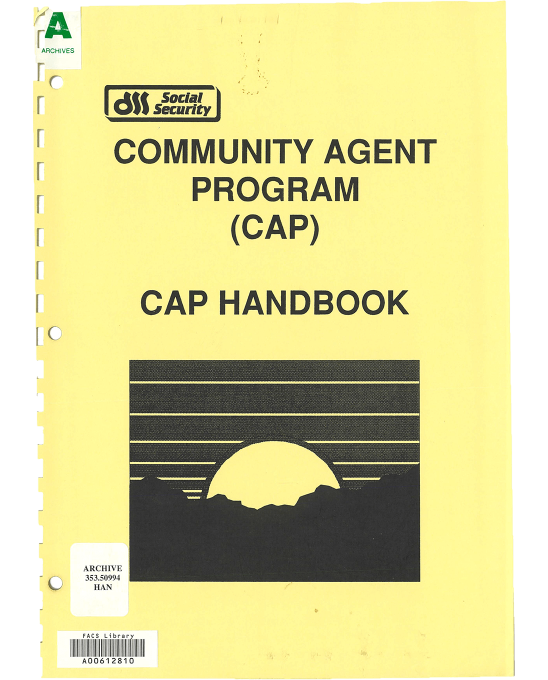
Community Agents support people in remote areas
In 1987, DSS began the Community Agent Program to help support Aboriginal people in remote and regional areas. In 1990, the department researched how to improve the program and followed up with a detailed handbook for agents.
... the Community Agents Program is a valuable means of delivering Department of Social Security services to remote Aboriginal communities.
| Attachment | Size |
|---|---|
| 90s-cap-report-and-handbook.pdf | 1.4 MB |
| Attachment | Size |
|---|---|
| community-agent-program-handbook-plaintext.docx | 93.35 KB |
The Department of Social Security (DSS) set up the Community Agent Program (CAP) in the late 1980s. The program employed local Aboriginal and Torres Strait Islander people in remote communities to help customers complete DSS tasks. This was important because some communities were far away from DSS offices and Aboriginal and Islander Liaison Officers (AILOs) were often stretched too thin to offer day-to-day support.
Working closely with AILOs, Community Agents answered questions about DSS programs, helped people fill in forms, helped people reply to letters and connected communities with the department.
Feedback on the program
In 1990, DSS wrote a report about how people viewed CAP.
The report recorded the perceptions and opinions of community members who Community Agents had helped. It also recorded the views of regional office staff who trained the agents.
Research from both groups found that CAP was a valuable way of helping people access DSS services in remote communities.
The report included areas for improvement and made 19 recommendations for addressing these areas.
The main issue was training for agents. Regional staff were concerned that training, especially advanced training, wasn’t well organised. There was also often no follow-up training.
Another issue was Community Agents moving between communities, leaving some places without agents. Local council staff were stepping in to try to help people when this happened, but it wasn’t the best solution.
Handbook for Community Agents
By 1994, there were more than 120 approved agents in Central Australia, the Northern Territory, northern Queensland and northern Western Australia.
To support Community Agents in their roles, DSS published a handbook. It briefly explained which payments Aboriginal and Torres Strait Islander people could get, and how and when to claim. It also listed other payments that might be available.
The handbook mentioned situations Aboriginal and Torres Strait Islander people might face in remote communities when applying for payments. It showed Community Agents how to prove someone’s identity without documents. It noted there were fewer rules to get Job Search Allowance in the Northern Territory. It also explained that payments in remote communities would usually come by cheque instead of direct bank deposit.
Following feedback, the handbook is an example of DSS adjusting their approach and working with local people in remote communities to help Aboriginal and Torres Strait Islander people get payments.
The Community Agent Program was a way of formalising existing service delivery arrangements.
In the early 1980s, academic Will Sanders had described that remote communities in the Northern Territory and Western Australia often had a representative who helped with people’s social security matters (1982:96–106). In Queensland ‘paid agents’ employed by DSS had begun operating in a few communities.
The Remote Area Task Force recommended the expansion of these early trials in their 1986 report (Flick 1986:21). CAP began as a formal pilot in 1987 with 10 communities involved. The program had expanded to 40 communities by June 1989 (DSS 1989:27).
Copies of this report and handbook are held in the Department of Social Services Library.
Citations
Department of Social Security (1994) Handbook for the guidance of Aboriginal and Torres Strait Islander community agents, Department of Social Security, Australian Government.
Hauff T (1990) Perceptions of the Community Agents Program, North Australia Development Unit, Department of Social Security, Australian Government.
